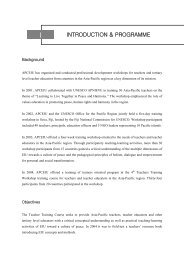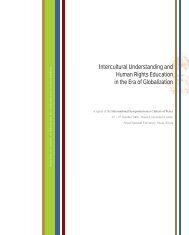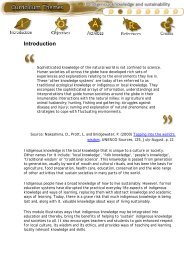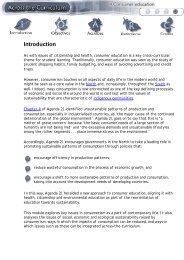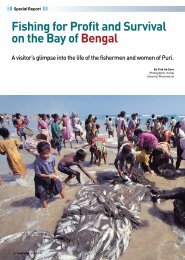REPORT OF UNESCO EXPERT MEETING ON - APCEIU
REPORT OF UNESCO EXPERT MEETING ON - APCEIU
REPORT OF UNESCO EXPERT MEETING ON - APCEIU
Create successful ePaper yourself
Turn your PDF publications into a flip-book with our unique Google optimized e-Paper software.
Adolescence<br />
(13-17 years)<br />
perspective and contributes to their<br />
development.<br />
Schools redirect behavioral<br />
patterns through the<br />
preferences of teachers and<br />
institution’s culture.<br />
A period of transition and rapid<br />
physical changes.<br />
The pursuit of independence and<br />
identity are preeminent.<br />
More and more time is spent<br />
outside the<br />
family; increased peer influence.<br />
- To avail of open and flexible learning systems<br />
- To participate in quality and relevant education<br />
that is appropriate to the child’s development stage<br />
and evolving capacity.<br />
- To receive free secondary education<br />
- To further avail of open and flexible learning<br />
systems<br />
- To further participate in quality and relevant<br />
education appropriate to the child’s development<br />
stage and evolving capacity<br />
- To participate in the development process<br />
This kind of presentation of child rights emphasizes two important points:<br />
a. It shows how human rights relate to daily life, and to the changing life and environment of the<br />
children. Some rights of children are more appropriate in certain stages in life.<br />
b. It provides an example of government policy and program developed using the human rights<br />
perspective.<br />
There are also principles governing child rights that should be noted:<br />
- best interest of the child – in realizing the rights of the child, the basic guide is that it should promote<br />
the best interest of the children concerned<br />
- participation – children (anyone below 18 years old) should be able to take part in making decisions<br />
on matters affecting them in accordance with their level of development and evolving capacity.<br />
In relation to human rights education, a key component is the identification of concrete issues affecting the<br />
students in various stages of their life that can be linked to human rights. This exercise can be done at school<br />
level through a human rights curricular framework as shown below.<br />
The Human Rights Curricular Framework – Indonesia 30<br />
Grade level<br />
HR curricular<br />
framework<br />
Issues Human rights concept Core values<br />
1<br />
2<br />
3<br />
Self<br />
Family<br />
Community<br />
- Malnutrition<br />
-Parental neglect<br />
-Domestic violence<br />
on women and<br />
children<br />
-corporal<br />
punishment at home<br />
- High death rate of<br />
children<br />
- Conflict situation<br />
- Conflict among<br />
ethnic groups<br />
- Right to life<br />
- Right to health<br />
-Right to protection<br />
-Right to protection<br />
-Right to seek medical<br />
help<br />
- Rights of indigenous<br />
peoples<br />
- Right to participate in<br />
- Love and care<br />
- Family and social<br />
protection<br />
- Care and treatment<br />
- Human dignity<br />
- Equality and justice<br />
- Human dignity<br />
- Diversity<br />
118



